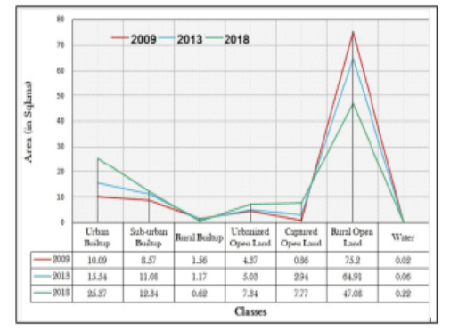
Geographical analysis
Department of Geography & GIS

Department of Geography & GIS

Geographical analysis
DOI: 10.53989/bu.ga.v12i2.23.4
Year: 2023, Volume: 12, Issue: 2, Pages: 1-6
Original Article
Arifa Begum1,2*, P C Tiwari1, Sandeep Maithani2
1Department of Geography, Kumaun University, Nainital
2Urban and Regional Studies Department, Indian Institute of Remote Sensing, Dehradun
*Corresponding Author
Email: [email protected]
Received Date:11 August 2023, Accepted Date:21 September 2023
Incessant urban growth has drastically transformed the urban landscapes. This has necessitated understanding of the spatial and temporal patterns of urban growth. Hence, the current research attempts to study and analyze the spatio-temporal patterns of urban growth using Urban Landscape Analysis Tool (ULAT) in the city of Rudrapur, Uttarakhand. In this study, land cover maps having three classes of urban, water-bodies and others are used to extract the degree of urbanization in the study area for the period 2009-2019. Subsequently, the Urbanized Area (UA), Urban Footprint (UF) and New Development (ND) maps are the resultant outputs generated. The urbanized area (UA) determined three levels of spatial density in the built-up area, namely, built-up area, the urbanized open land, and the captured open land. Similarly the urban footprint (UF) also discerns the built-up area, the fringe open land, and the captured open. New development map had the following three classes, infill (newly developed pixels that are in the urbanized open); extension (newly developed pixels that are in the fringe open land of the previous time period); and leapfrog (newly developed pixels that are outside of the rural open land of the previous time period). The sub classes of the built-up area give insights to the changing morphology of the city with time. The findings of the study suggest that the pattern transformation in the city of Rudrapur is taking place towards the north, north-western and south-eastern directions. Hence, this study enables in understanding and analyzing the urban expansion and its patterns; and eventually the identification of the priority areas for better planning and management of the city for sustainable urbanism.
Keywords: Urban Growth, Urban Landscape Analysis Tool, Spatial density
© 2023 Begum et al. This is an open-access article distributed under the terms of the Creative Commons Attribution License, which permits unrestricted use, distribution, and reproduction in any medium, provided the original author and source are credited.
Published By Bangalore University, Bengaluru, Karnataka
Subscribe now for latest articles and news.